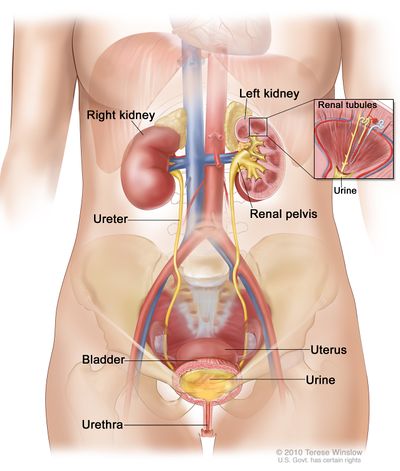Chronic Kidney Disease
This article or area is currently under construction and may only be partially complete. Please come back soon to see the finished work! (20/10/2020)
Original Editor - Lucinda hampton
Top Contributors - Lucinda hampton, Bruno Serra, Vidya Acharya and Kim Jackson
Introduction[edit | edit source]
Chronic kidney disease (CKD):
- A progressive loss of glomerular function caused by a long-standing renal parenchymal disease. It is present when the glomerular filtration rate (GFR) is less than 60 ml/min/1.73 m2 for three consecutive months or greater than or equal to this value in patients with a kidney damage that is present for three or more months.[1]
- A non-communicable disease usually caused by diabetes and hypertension[2]
- Often involves a progressive loss of kidney function necessitating renal replacement therapy (dialysis or transplantation). When a patient needs renal replacement therapy, the condition is called end-stage renal disease (ESRD)[3].
Function[edit | edit source]
Filter the blood to remove excess water, minerals, and waste products of protein metabolism, producing urine in the process
Kidneys are involved in
- Blood pressure regulation
- Regulation of body fluid volume, osmolality and pH
- Vitamin D and red blood cell (RBC) production
Renal function tests
- Estimated glomerular filtration rate (eGFR)
- Electrolytes
- Blood urea nitrogen (BUN) (urea in the UK)
- Creatinine levels[4]
Epidemiology[edit | edit source]
CKD is a prevalent disease, affecting between 10-15% of the adult population globally[1]
- The true incidence and prevalence of CKD are difficult to determine because of the asymptomatic nature of early to moderate CKD.
- The prevalence of CKD is around 10% to 14% in the general population[5].
- Worldwide, CKD accounted for 2,968,600 (1%) of disability-adjusted life-years and 2,546,700 (1% to 3%) of life-years lost in 2012.
- In 2017, the global prevalence of CKD was 9·1%, roughly 700 million cases.
- Since 1990, the prevalence of CKD has increased by 29·3%.
- A substantial increase was noted in age-standardised incidence of end-stage kidney disease (ESKD) treated by renal replacement therapy, with dialysis and kidney transplantation increasing by 43·1% and 34·4%, respectively.
- The global age-standardised mortality rate for CKD is not declining, unlike those for other important non-communicable diseases.[2]
Sub Heading 2[edit | edit source]
Sub Heading 3[edit | edit source]
Resources[edit | edit source]
- bulleted list
- x
or
- numbered list
- x
References[edit | edit source]
- ↑ 1.0 1.1 Radiopedia CKD Available from:https://radiopaedia.org/articles/chronic-kidney-disease (last accessed 20.10.20)
- ↑ 2.0 2.1 Cockwell P, Fisher LA. The global burden of chronic kidney disease. The Lancet. 2020 Feb 29;395(10225):662-4.Available from:https://www.thelancet.com/journals/lancet/article/PIIS0140-6736(19)32977-0/fulltext (last accessed 20.10.2020)
- ↑ Radiopedia Kidney Failure Available from:https://www.ncbi.nlm.nih.gov/books/NBK519012/ (last accessed 20.10.2020)
- ↑ Radiopedia Kidneys Available from:https://radiopaedia.org/articles/kidneys (last accessed 20.10.2020)
- ↑ Vaidya SR, Aeddula NR. Chronic Renal Failure. InStatPearls [Internet] 2019 Dec 7. StatPearls Publishing.Available from:https://www.ncbi.nlm.nih.gov/books/NBK535404/ (last accessed 20.10.2020)







